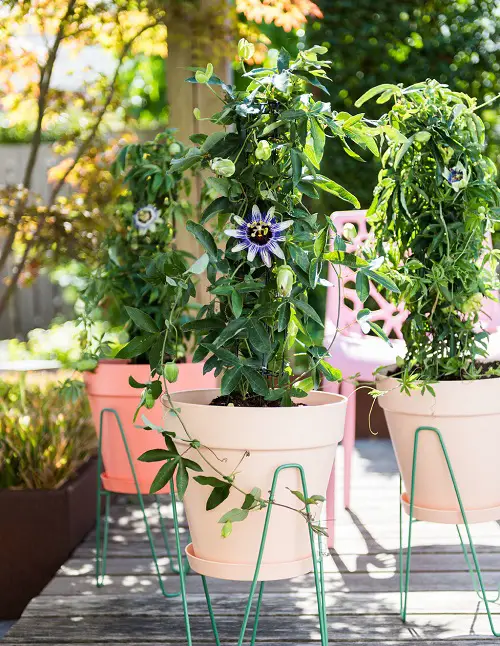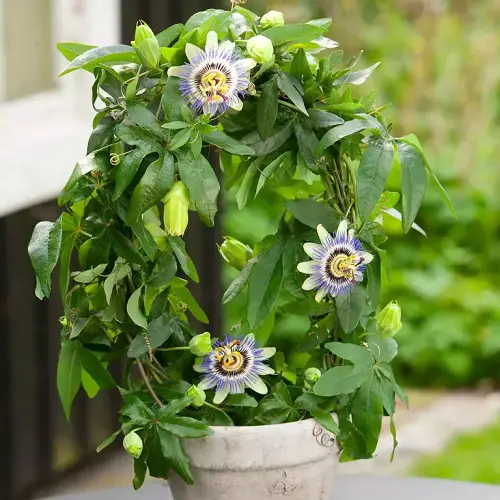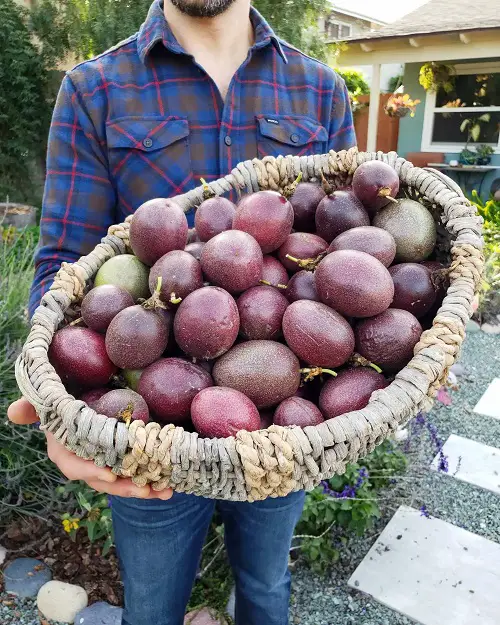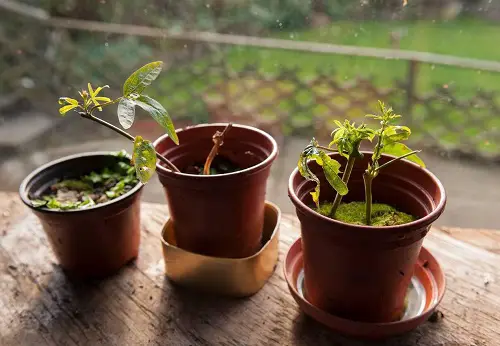Passiflora Caerulea stands out with its flowers that perfectly match its green tropical foliage. Here’s How to Grow Blue Passion Flower!

Passiflora caerulea is a gorgeous vine with stunning blooms that’ll knock your socks off. But don’t worry, taking care of it isn’t rocket science. In fact, with a few simple tips, you can grow this beauty yourself and enjoy its lovely blooms in your garden. Just follow our guide.
Passiflora Caerulea Information
This plant is actually a South American native. Gardeners cherish it because it’s easy to grow and can thrive in many different climates. It’s a great vine to grow in the garden, spreading fast and attracting many butterflies and bees.
Blue passionflowers have large, intricate flowers in a purple/blue and white shade. Their leaves are lobed and dark green, perfectly creating a lush background to make the flowers stand out.
These vines also produce about 2-3 inches big and slightly oval fruits called blue ground passionfruit. They appear in late summer or early fall and turn yellow when ripe. But enough about the vine, we’re sure you want to see these for yourself. Let’s take a look at how you can grow it.
Pro Tip: If you’re going to grow it, you should choose the best Passiflora caerulea varieties–Constance Elliot, Clear Sky, and Chinensis.
Common Names: Passionflower, blue passion flower, passion fruit, Jesus flower
Botanical Name: Passiflora caerulea
USDA Zones: 8-11
Propagating Passiflora Caerulea
Passiflora caeruleas can easily be propagated via seeds, cuttings, and layering. However, we suggest you do it via cuttings because it’s the best method–cuttings result in faster rooting and have a high success rate.
Take a young, flexible softwood cutting (4-6 inches long with 2-3 sets of leaves) of the plant—the smart way is to get it from a local garden center or perhaps a friend who has it. Once you have the cutting, remove the leaves on the lower portion and leave it to callous for a day or two. Take it during the spring when the vine is in full bloom, but avoid stems with flowers.
Once ready, gently insert the cutting into a small pot or tray with good-quality potting mix. 1-2 inches deep is great. Mist the soil properly and keep it on a sunny windowsill. The cutting will root in about 2-4 weeks and start growing into a beautiful Passionflower vine.
Pro Tip: You can check for root development by gently tugging on the cutting. Resistance indicates that the roots are forming.
Choosing a Container for Passiflora Caerulea
To grow Passiflora caerulea, you need a pot with plenty of space for root development and vertical growth.
You should start your plant in a 5-gallon or 7-gallon container so the roots can spread, and as it matures, you should repot it to a larger one.
When to Plant Passiflora Caerulea?
Knowing when to plant this vine can make a huge difference, as it can make or break your plant’s health. We don’t want it to struggle when starting out, do we? Plant your Passiflora caerulea outdoors in mid-spring or fall, considering your area’s climate. Here’s the breakdown.
1. Planting in Frost-Free Climates (USDA Zones 10-12)
In tropical or subtropical regions where frost is never a concern, you can plant them in early to mid-spring and take advantage of the growing season. You can also do it in early summer–avoid the peak heat.
Planting during the peak summer heat can cause stress to the young plant, so you should avoid it.
2. Planting in Warm Climates (USDA Zones 8-10)
If you live in a place with a warm and temperate climate, you can plant these lovely vines any time of the year because there’s little to no danger of frost.
3. Planting in Cold Climates (USDA Zones 5-8)
In colder regions where frost and freezing temperatures are regular season occurrences, you should plant Passiflora caerulea in late spring, after the last expected frost date has passed.
You can check it for your area online and then plant the cutting so it has the full growing season to establish itself.
Can Passiflora Caerulea be Grown Indoors?
Of course, you can grow Passiflora caerulea indoors. In fact, it’s one of the most popular passionflower varieties that is grown as a houseplant. Give it a sunny window that gets 5-6 minimum hours of sun, and it’ll thrive.
Pro Tip: When growing it indoors, go for a soilless mix that’s based on peat moss–it drains well, which helps prevent root rot, and is lightweight, making it easier to move your passionflower around to get the best sunlight.
Requirements for Growing Passiflora Caerulea
Sunlight
Passiflora caerulea needs full sun but also thrives in partial sunlight. Make sure you keep it someplace where it can get 5-6 hours of direct sunlight daily. Indoors, that would be a south-facing window.
While this vine enjoys sunlight, it needs protection from harsh afternoon sun in regions with intense sunlight, as it can scorch the leaves. You can plant it near a fence or wall or put up a curtain so it gets filtered light during those peak hours.
Soil
These flowering vines love well-draining soil rich in organic matter. Here’s a soil mix recipe that will work for them both indoors and outdoors.
- 2 parts Coconut Coir (You can also use Peat Moss) for base
- 1 part Perlite for drainage and aeration
- 1 part Horticultural Charcoal for purifying and drainage
Once you have all of these ready, mix them up in a pot and plant your Passiflora caerulea in it. It will thank you with healthy and long vines full of pretty flowers.
Watering
These vines usually need watering once every 1-2 weeks, but you’ll have to adjust the watering a bit according to the weather. In warmer months, you’ll need to water it once every 2-3 days, and in cool weather, it would be once every 7-10 days, maybe even longer.
The best trick is to check the topsoil. If it’s dry, water it. If it’s moist, leave it be. Whenever you water, do it deeply and pour the water into the pot directly instead of wetting the foliage.
Temperature
Passiflora caerulea prefers a temperate to subtropical climate , which is about 65°F to 85°F (18°C to 29°C). The plant can tolerate hot temperatures up to 100°F (38°C) easily and short periods of cooler temperatures down to around 32°F (0°C), but prolonged frost can damage or kill the plant.
During colder periods, especially in regions near or below freezing, blue passion flower vine requires protection to prevent damage. If grown in containers, you should move the plant indoors or to a sheltered location when frost is expected. For plants in the ground, covering them with frost cloth or burlap can help insulate them.
Passiflora Caerulea Care
Fertilizer
A good option is a fertilizer with a balanced NPK ratio, like a 6-6-6 or 5-7-5 blend. Use the fertilizer during the growing season, which is typically spring and summer. You can feed your plant every 4-6 weeks with a diluted solution according to the fertilizer’s instructions.
Be sure to stop fertilizing in the fall and winter as the plant goes dormant and doesn’t need the extra nutrients. Overfertilizing can harm your Passiflora caerulea, so it’s better to err on the side of less.
You can also use compost for your blue passionflower vine. Use it to topdress the pot occasionally during the growing season, but don’t use it too much because it can retain moisture and lead to fungal growth.
Support
These vines can easily grow 10-20 feet tall, so you’ll need to give them proper support. You can go with an arbor or a fence on the lawn. If you’re growing it in a pot indoors, a moss pole is good. Here are some ideas you can use. You can also train it to grow on walls and even the ceiling with the help of rope and wall hooks.
Pruning
Pruning helps the plant grow healthier and produce more flowers so make sure you give it a little snip in late winter / early spring before the new growth begins. Get rid of any dead, damaged, or diseased stems. Cut back the overgrown or crossing branches to keep it neat and tidy and promote better air circulation.
When pruning, make the cuts just above leaf nodes–it will help sprout new growth from that point. Don’t prune more than one-third of the vine in one go.
Overwintering
Overwintering Passiflora caerulea is important to protect it from cold weather. If you live in an area where the winters are cold, your vine can get killed by frost, so you have to overwinter it to help it survive till the warm weather returns.
If you’re growing it indoors, it’ll be fine as long as it gets proper sun and is watered the right way. Outdoors, you should mulch around the base to protect the roots and cover it with burlap.
Pests and Diseases
You might see aphids, spider mites, and whiteflies on your blue passion flower vine because they’re the common culprits. They damage the vine by sucking sap from the foliage, but you can get rid of them easily by spraying them with a mixture of water and dish soap. Neem oil works, too!
Common diseases that people usually have problems with are root rot and leaf spot. You can take care of root rot by watching the watering schedule and avoiding overwatering. For leaf spots, you need to remove all affected leaves.
Harvesting Bluecrown Passionflower Fruit

Passiflora caerulea’s passionfruit typically takes around 80 to 90 days to mature after flowering. You’ll know when to pick it when the flesh turns from green to an orange/yellow shade.
Gently grab these fruits and twist them to remove them from the vine. Wash these gently and pat them dry with a clean cloth and paper towel. Now, you can enjoy these lovely fruits and their flavor.
You can also store these for 3-4 days easily if the atmosphere is dry. If you want to keep them longer, store them in an air-tight container in the refrigerator. They’ll easily last 10-12 days that way.
Well, what are you waiting for? Now that you know how to grow the Passiflora caerulea vine, it’s time to try it yourself and enjoy the lovely flowers and delicious fruits. Do let us know about your experience in the comments!






